Module 6 Unit 2 The WWF is working hard to save them all.说课课件(共35张PPT)外研版英语八年级上册
文档属性
| 名称 | Module 6 Unit 2 The WWF is working hard to save them all.说课课件(共35张PPT)外研版英语八年级上册 | 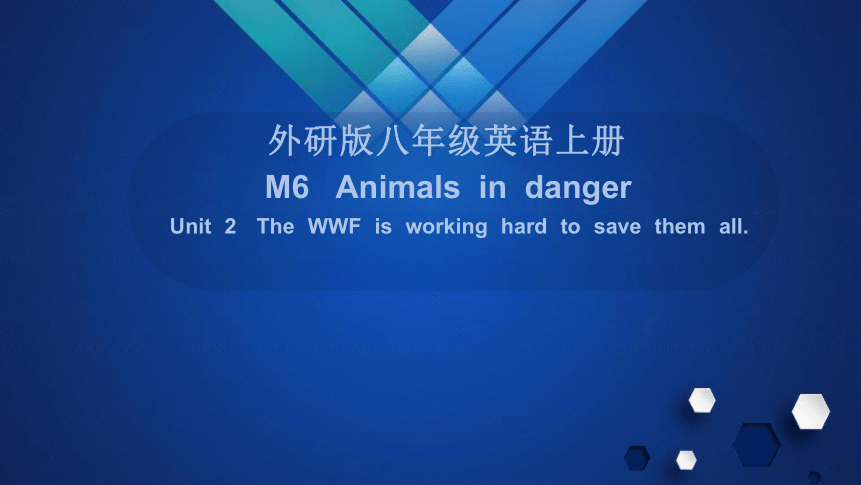 | |
| 格式 | pptx | ||
| 文件大小 | 7.3MB | ||
| 资源类型 | 教案 | ||
| 版本资源 | 外研版 | ||
| 科目 | 英语 | ||
| 更新时间 | 2023-07-06 21:19:56 | ||
图片预览

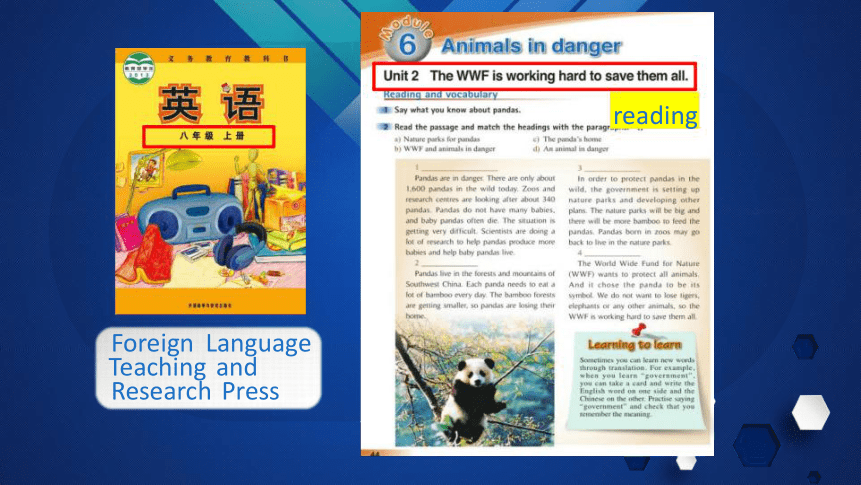
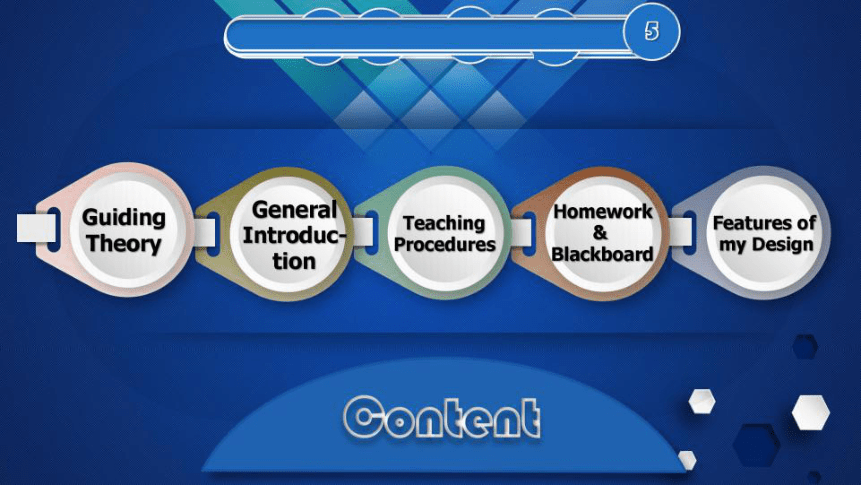
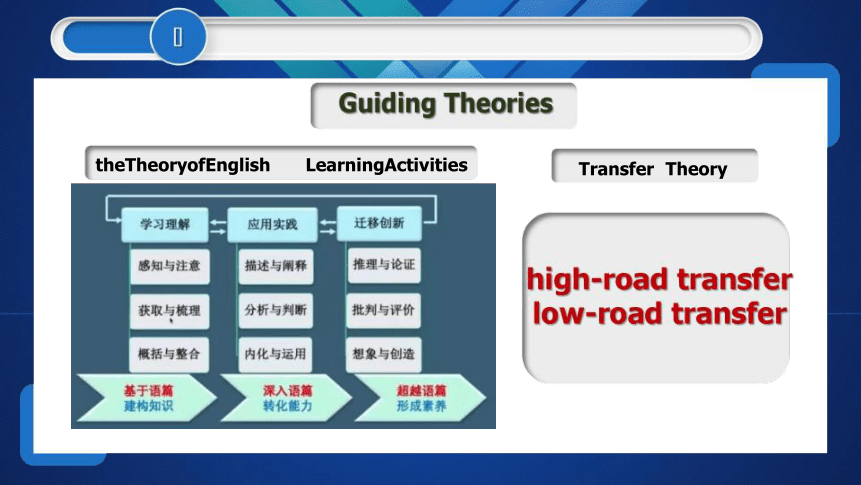
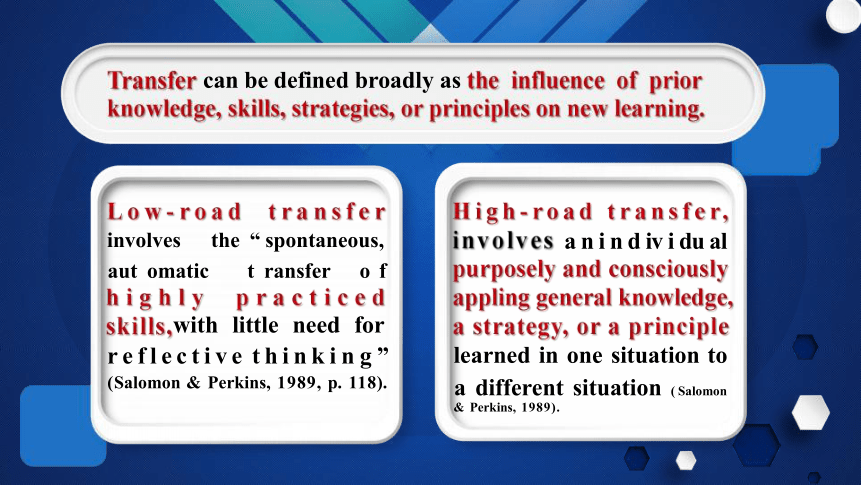
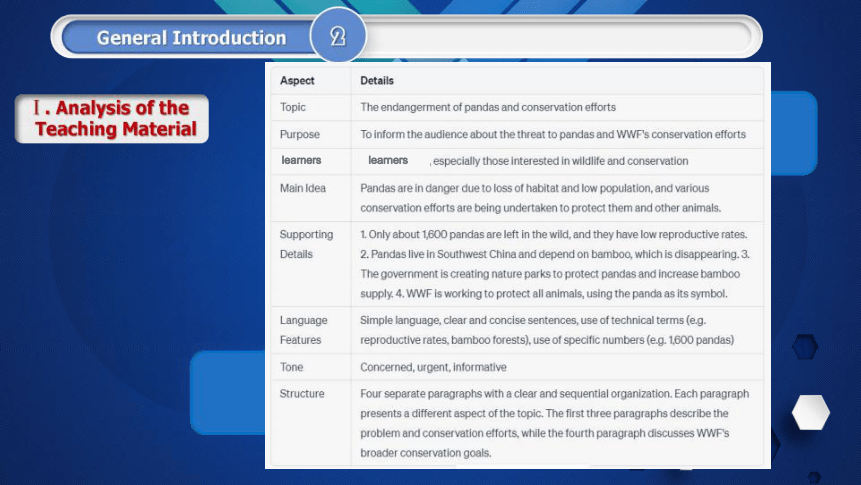
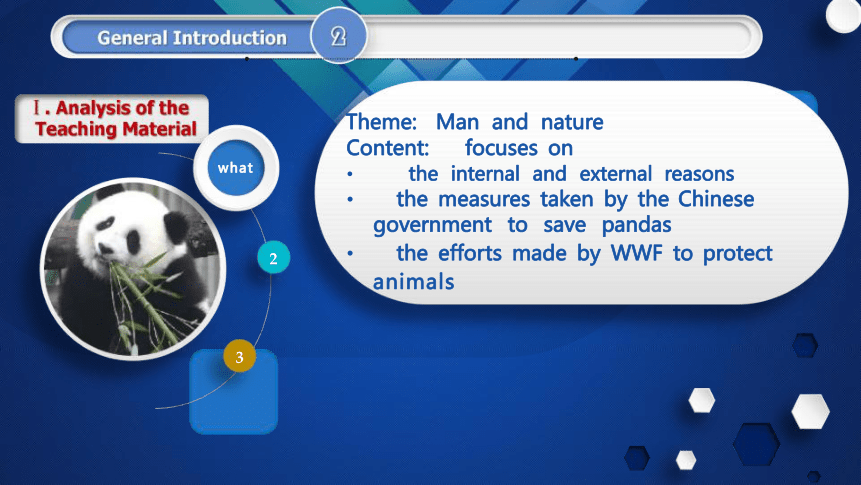
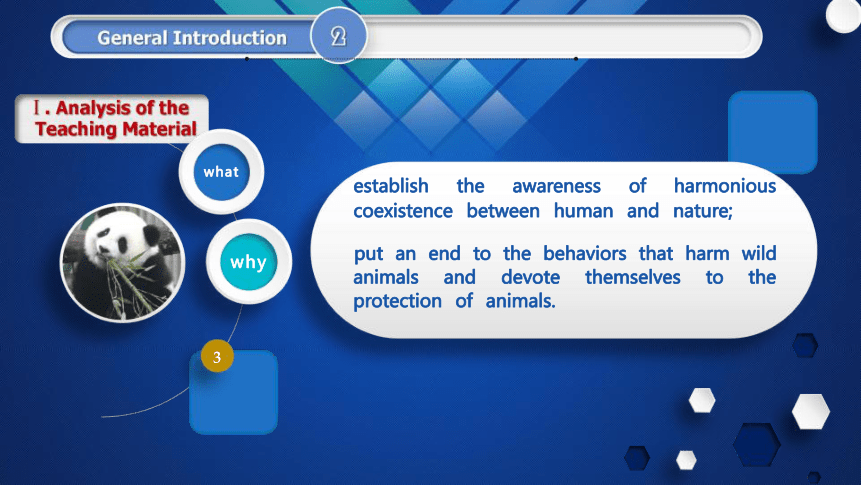
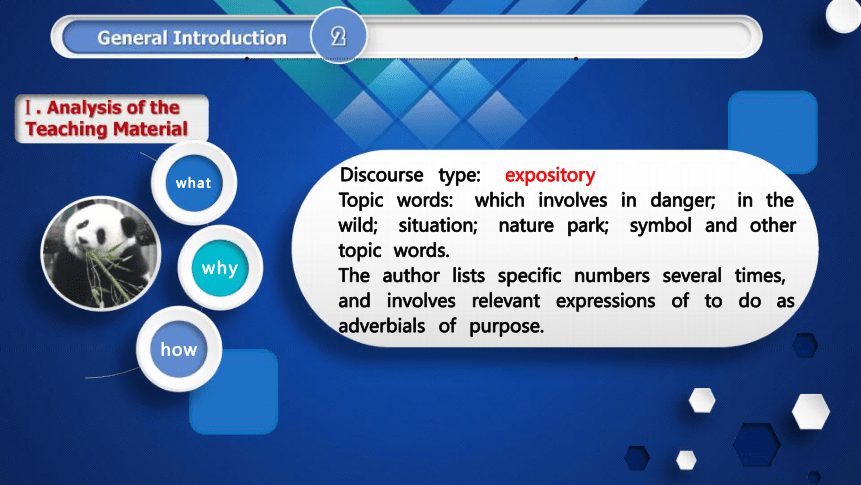
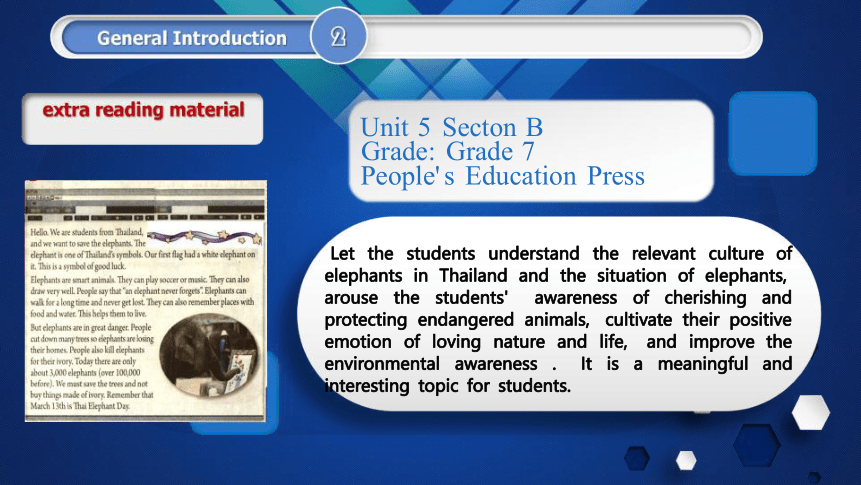
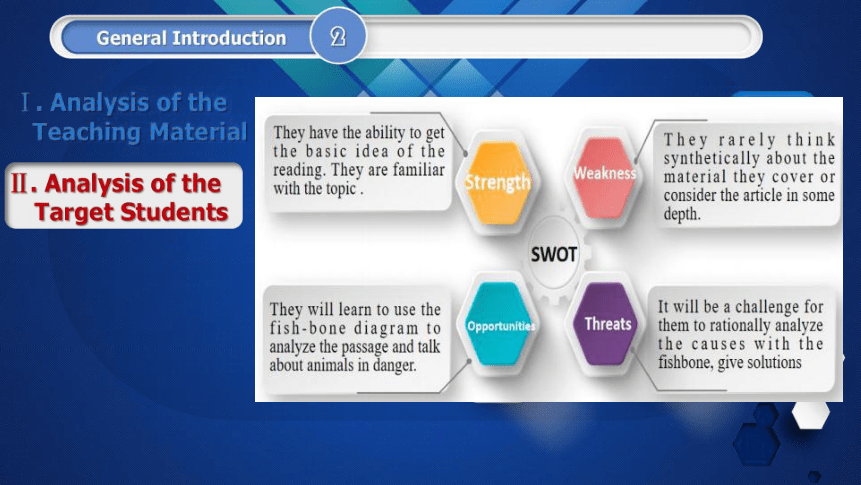
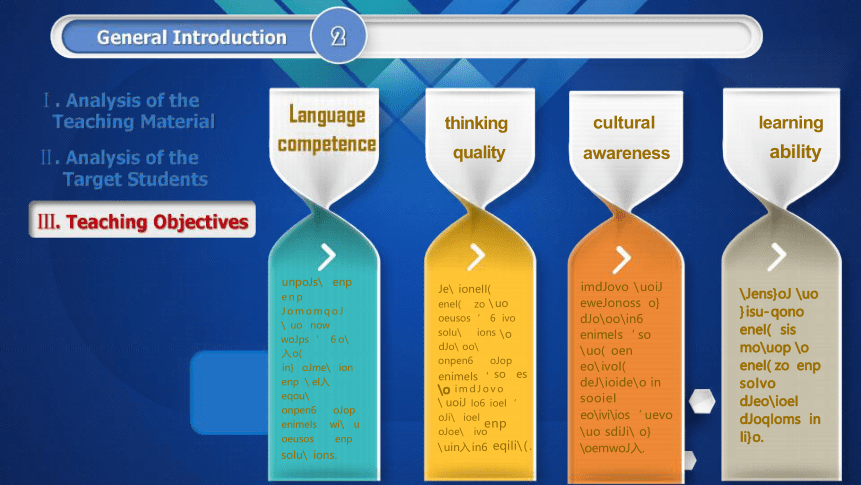
文档简介
(共35张PPT)
外研版八年级英语上册
M6 Animals in danger
Unit 2 The WWF is working hard to save them all.
Foreign Language
Teaching and
Research Press
reading
theTheoryofEnglish LearningActivities
Transfer Theory
involves the “spontaneous,
aut omatic t ransfer o f
with little need for r e f l e c t i v e t h i n k i n g ” (Salomon & Perkins, 1989, p. 118).
learned in one situation to a different situation (Salomon
can be defined broadly as
a n i n d iv i du al
& Perkins, 1989).
learners
learners
2
Theme: Man and nature
Content: focuses on
the internal and external reasons
the measures taken by the Chinese government to save pandas
the efforts made by WWF to protect animals
what
3
establish the awareness of harmonious coexistence between human and nature;
put an end to the behaviors that harm wild animals and devote themselves to the protection of animals.
what
why
3
Discourse type: expository
Topic words: which involves in danger; in the wild; situation; nature park; symbol and other topic words. The author lists specific numbers several times, and involves relevant expressions of to do as adverbials of purpose.
what
why
how
Let the students understand the relevant culture of elephants in Thailand and the situation of elephants, arouse the students' awareness of cherishing and protecting endangered animals, cultivate their positive emotion of loving nature and life, and improve the environmental awareness . It is a meaningful and interesting topic for students.
Unit 5 Secton B
Grade: Grade 7
People's Education Press
Strength
Weakness
SWOT
Threats
Opportunities
thinking quality
unpoJs\enp
enp
JomomqoJ
\uo now
woJps‘ 6o\
入o(
in}oJme\ion
enp \eI入
eqou\
onpen6oJop
enimeIs wi\u
oeusos enp
soIu\ions.
imdJovo \uoiJ eweJonoss o} dJo\oo\in6 enimeIs‘ so \uo( oen eo\ivoI( deJ\ioide\o in sooieI
eo\ivi\ios‘ uevo \uo sdiJi\ o} \oemwoJ入.
\o
Je\ioneII(
eneI(zo
oeusos‘
soIu\ions
dJo\oo\
onpen6oJop
enimeIs‘
\uoiJ
oJi\ioeI
oJoe\ivo
\uin入in6
\Jens}oJ \uo }isu-qono eneI(sis mo\uop \o eneI(zo enp soIvo dJeo\ioeI dJoqIoms in Ii}o.
\uo
6ivo
\o
so es
imdJovo
Io6ioeI‘
enp eqiIi\(.
cultural awareness
learning ability
und erstand the artic l e a b out the
s ituation of end ang ered p and as
analyze the artic l e w ith the fis h - b one
Difficult diag ram, fin d the causes and sol utions
point and solve the difficult thin king p roblems .
Key point a n d e l e p h a n t s a n d i n t ro d u c e
endangered ani mals .
PWP
vision-based teaching method
CAI
Blackboard Learning sheets
Evaluation
Self-evaluation
Peer-evaluation
Teacher's evaluation
Teaching objectives
Activity Design
Analysis of teaching material
Analysis of learners
Step 5: Extension
Step 4: Post-reading
Step 3: While-reading
Step 2: Pre-reading
Step 1 : Lead in
Five stepsaredesignedtoexplorethethematic meaningand reflectcognitive
levels
Purpose: Leadinandlearnthewords.Stimulatingstudents' prior
knowledgehelpsthemunderstandtherelevance,sothattheycan
integratetheoldandnewknowledgeandpromotetransfer.
The panda is its s_ _m_bol____/ _s. mbl/
Why did the WWF choose the panda to be its symbol
Pandas in the wild were in danger
The situation was serious. The government set up nature parks for them.
Unit 2 The WWF is working hard to save them all.
(The World Wide Fund for Nature世界自然基金会)
What is the WWF
What is the WWF doing
What does it usually do
What does it usually save
Step 1:Lead in activity 1: talk and learn
Purpose: Generalizationisthepremiseofhigh-roadtransfer.Hopefuly
studentscantransferthismindmaptointroduceotheranimals.
u Introduction of pandas
Have you seen pandas before
Where did you see them
Step 2: Pre-reading activity 2:talk and introduce
How much do you know about pandas
Write down the key words to summarize a mind map.
1.Why are pandas in danger Ask more questions “Why
do the baby pandas die Why are the bamboo forests getting smaller What
are other possible causes etc.
Purpose: Enablestudentstogetmoreinformationaboutpandasin
dangeranddevelopstudents’logicalthinkingability.
Step 3:while-reading activity 3:read and answer
Pandas don't have many babies, and baby pandas often die.
The bamboo
forests are getting
smaller, so pandas
are losing their
home.
read and answer
Purpose: Developstudents’logicalthinkingability.
What are the solutions
Purpose: Developstudents’criticalandcreativethinkingability.
activity 4:
Usingtheprincipleoflow-roadtransfer,studentscanrepeatwhatthey
What are other
solutions to the
causes listed above
havelearnedindifferentcontexts.
discuss and report
Purpose: Learningmaterialshavethesameandsimilarcomponents,usingthelearned
knowledgeandstrategiestosolvenewproblems.Usingtheprincipleofhigh-roadtransfer,
weconsciouslyaplytheabstractknowledgetotheintroductionofelephants.
activity 5: read and introduce
Purpose: Byhigh-roadtransfer,thefishboneanalysisisusedtoanalyze
thecausesandsolutions.Itisabackwardtransfer. Thenewlylearned
knowledgecanhaveapositiveimpactonthemasteredknowledgeand
skils.
activity 6: read and draw
Purpose: identify the situation for transfer and use the summarized
knowledge in introductions of different endangered
Discuss and list more causes and solutions and then give a report about
elephants in danger.
Tip:
If we focus on a problem with the fishbone, we can know the causes clearly and give related
Step 4:Post-reading Discuss and list more causes and solutions and
activity 7:group work then give a report about elephants in danger.
animals.
solutions.
Step 5 Extension
activity 8:compare
Purpose: depentheirunderstanding,consolidatewhattheyhave
learned,andenablethemtoaplytheknowledge.
Purpose: alowstudentstomonitortheirprogresandcheckwhether
theyhaveachievedtheobjectives.
Activitiesareinterrelatedin alogicalwaytofacilitateastudent-orientedteaching
process.
To pave the way for activities
7,8
The output of the whole
process.
To lay the
Activ 3, 4
ities
ities
ities
ities
ities
ities
ities
ities
ities
cti
8
ity
ity
ity
v
cti
cti
cti
A
7
,
6
,
5
ities
ities
ities
ities
ities
v
cti
cti
cti
A
Acti
cti
2
,
1
ities
ities
ities
ities
ities
v
cti
cti
cti
A
Acti
Step 2
Pre-reading
Step 4
Post-reading
Step 5
Extension
A
A
A
A
A
A
cti
9
ity
ity
ity
v
cti
cti
cti
A
Step 1
Lead in
Step 3
While-reading
foundation for the
following activities.
1.Required homework.
A. Introduce pandas or elephants based on the analysis of a fishbone diagram
B. Use a fishbone diagram to analyze the c a u s e s o f e n d a n g e r m e n t f o r a n e n d a n g e r e d a n i m a l , a n d p r o v i de solutions.
2.Optional homework:
Do a survey and make a poster to raise awareness and support the conservation of a n en dan gered an imal . ( in cl u de : introduction, causes and solutions)
Apply and transfer knowledge learned beyond class.
Stimulate students' creativity and interest in related topics.
Improve their awareness of protecting animals
Highlights
01
02
03
Show the topic and the key words .
Highlight the mind map and fishbone diagram.
Be constructed by students and the teacher in the practical teaching.
15m
01
30 m
Highlights
03
02
10m
Analysis of
the learners
from
multiple
perspectives
mind map fishbone diagram Venn diagram
Analysis of
he learners from
multiple erspectives
Activities
were
designed
with
different
tools
t
P
Activities
were
designed
under the
guidance of
Transfer
high-road
transfer and low-road transfer
Analysis of
the learners
from
multiple
Perspectives
Activity
were
designed
with
different
tools
Theory
Thank you
外研版八年级英语上册
M6 Animals in danger
Unit 2 The WWF is working hard to save them all.
Foreign Language
Teaching and
Research Press
reading
theTheoryofEnglish LearningActivities
Transfer Theory
involves the “spontaneous,
aut omatic t ransfer o f
with little need for r e f l e c t i v e t h i n k i n g ” (Salomon & Perkins, 1989, p. 118).
learned in one situation to a different situation (Salomon
can be defined broadly as
a n i n d iv i du al
& Perkins, 1989).
learners
learners
2
Theme: Man and nature
Content: focuses on
the internal and external reasons
the measures taken by the Chinese government to save pandas
the efforts made by WWF to protect animals
what
3
establish the awareness of harmonious coexistence between human and nature;
put an end to the behaviors that harm wild animals and devote themselves to the protection of animals.
what
why
3
Discourse type: expository
Topic words: which involves in danger; in the wild; situation; nature park; symbol and other topic words. The author lists specific numbers several times, and involves relevant expressions of to do as adverbials of purpose.
what
why
how
Let the students understand the relevant culture of elephants in Thailand and the situation of elephants, arouse the students' awareness of cherishing and protecting endangered animals, cultivate their positive emotion of loving nature and life, and improve the environmental awareness . It is a meaningful and interesting topic for students.
Unit 5 Secton B
Grade: Grade 7
People's Education Press
Strength
Weakness
SWOT
Threats
Opportunities
thinking quality
unpoJs\enp
enp
JomomqoJ
\uo now
woJps‘ 6o\
入o(
in}oJme\ion
enp \eI入
eqou\
onpen6oJop
enimeIs wi\u
oeusos enp
soIu\ions.
imdJovo \uoiJ eweJonoss o} dJo\oo\in6 enimeIs‘ so \uo( oen eo\ivoI( deJ\ioide\o in sooieI
eo\ivi\ios‘ uevo \uo sdiJi\ o} \oemwoJ入.
\o
Je\ioneII(
eneI(zo
oeusos‘
soIu\ions
dJo\oo\
onpen6oJop
enimeIs‘
\uoiJ
oJi\ioeI
oJoe\ivo
\uin入in6
\Jens}oJ \uo }isu-qono eneI(sis mo\uop \o eneI(zo enp soIvo dJeo\ioeI dJoqIoms in Ii}o.
\uo
6ivo
\o
so es
imdJovo
Io6ioeI‘
enp eqiIi\(.
cultural awareness
learning ability
und erstand the artic l e a b out the
s ituation of end ang ered p and as
analyze the artic l e w ith the fis h - b one
Difficult diag ram, fin d the causes and sol utions
point and solve the difficult thin king p roblems .
Key point a n d e l e p h a n t s a n d i n t ro d u c e
endangered ani mals .
PWP
vision-based teaching method
CAI
Blackboard Learning sheets
Evaluation
Self-evaluation
Peer-evaluation
Teacher's evaluation
Teaching objectives
Activity Design
Analysis of teaching material
Analysis of learners
Step 5: Extension
Step 4: Post-reading
Step 3: While-reading
Step 2: Pre-reading
Step 1 : Lead in
Five stepsaredesignedtoexplorethethematic meaningand reflectcognitive
levels
Purpose: Leadinandlearnthewords.Stimulatingstudents' prior
knowledgehelpsthemunderstandtherelevance,sothattheycan
integratetheoldandnewknowledgeandpromotetransfer.
The panda is its s_ _m_bol____/ _s. mbl/
Why did the WWF choose the panda to be its symbol
Pandas in the wild were in danger
The situation was serious. The government set up nature parks for them.
Unit 2 The WWF is working hard to save them all.
(The World Wide Fund for Nature世界自然基金会)
What is the WWF
What is the WWF doing
What does it usually do
What does it usually save
Step 1:Lead in activity 1: talk and learn
Purpose: Generalizationisthepremiseofhigh-roadtransfer.Hopefuly
studentscantransferthismindmaptointroduceotheranimals.
u Introduction of pandas
Have you seen pandas before
Where did you see them
Step 2: Pre-reading activity 2:talk and introduce
How much do you know about pandas
Write down the key words to summarize a mind map.
1.Why are pandas in danger Ask more questions “Why
do the baby pandas die Why are the bamboo forests getting smaller What
are other possible causes etc.
Purpose: Enablestudentstogetmoreinformationaboutpandasin
dangeranddevelopstudents’logicalthinkingability.
Step 3:while-reading activity 3:read and answer
Pandas don't have many babies, and baby pandas often die.
The bamboo
forests are getting
smaller, so pandas
are losing their
home.
read and answer
Purpose: Developstudents’logicalthinkingability.
What are the solutions
Purpose: Developstudents’criticalandcreativethinkingability.
activity 4:
Usingtheprincipleoflow-roadtransfer,studentscanrepeatwhatthey
What are other
solutions to the
causes listed above
havelearnedindifferentcontexts.
discuss and report
Purpose: Learningmaterialshavethesameandsimilarcomponents,usingthelearned
knowledgeandstrategiestosolvenewproblems.Usingtheprincipleofhigh-roadtransfer,
weconsciouslyaplytheabstractknowledgetotheintroductionofelephants.
activity 5: read and introduce
Purpose: Byhigh-roadtransfer,thefishboneanalysisisusedtoanalyze
thecausesandsolutions.Itisabackwardtransfer. Thenewlylearned
knowledgecanhaveapositiveimpactonthemasteredknowledgeand
skils.
activity 6: read and draw
Purpose: identify the situation for transfer and use the summarized
knowledge in introductions of different endangered
Discuss and list more causes and solutions and then give a report about
elephants in danger.
Tip:
If we focus on a problem with the fishbone, we can know the causes clearly and give related
Step 4:Post-reading Discuss and list more causes and solutions and
activity 7:group work then give a report about elephants in danger.
animals.
solutions.
Step 5 Extension
activity 8:compare
Purpose: depentheirunderstanding,consolidatewhattheyhave
learned,andenablethemtoaplytheknowledge.
Purpose: alowstudentstomonitortheirprogresandcheckwhether
theyhaveachievedtheobjectives.
Activitiesareinterrelatedin alogicalwaytofacilitateastudent-orientedteaching
process.
To pave the way for activities
7,8
The output of the whole
process.
To lay the
Activ 3, 4
ities
ities
ities
ities
ities
ities
ities
ities
ities
cti
8
ity
ity
ity
v
cti
cti
cti
A
7
,
6
,
5
ities
ities
ities
ities
ities
v
cti
cti
cti
A
Acti
cti
2
,
1
ities
ities
ities
ities
ities
v
cti
cti
cti
A
Acti
Step 2
Pre-reading
Step 4
Post-reading
Step 5
Extension
A
A
A
A
A
A
cti
9
ity
ity
ity
v
cti
cti
cti
A
Step 1
Lead in
Step 3
While-reading
foundation for the
following activities.
1.Required homework.
A. Introduce pandas or elephants based on the analysis of a fishbone diagram
B. Use a fishbone diagram to analyze the c a u s e s o f e n d a n g e r m e n t f o r a n e n d a n g e r e d a n i m a l , a n d p r o v i de solutions.
2.Optional homework:
Do a survey and make a poster to raise awareness and support the conservation of a n en dan gered an imal . ( in cl u de : introduction, causes and solutions)
Apply and transfer knowledge learned beyond class.
Stimulate students' creativity and interest in related topics.
Improve their awareness of protecting animals
Highlights
01
02
03
Show the topic and the key words .
Highlight the mind map and fishbone diagram.
Be constructed by students and the teacher in the practical teaching.
15m
01
30 m
Highlights
03
02
10m
Analysis of
the learners
from
multiple
perspectives
mind map fishbone diagram Venn diagram
Analysis of
he learners from
multiple erspectives
Activities
were
designed
with
different
tools
t
P
Activities
were
designed
under the
guidance of
Transfer
high-road
transfer and low-road transfer
Analysis of
the learners
from
multiple
Perspectives
Activity
were
designed
with
different
tools
Theory
Thank you
同课章节目录
- Module 1 How to learn English
- Unit 1 Let's try to speak English as much as possi
- Unit 2 You should smile at her.
- Unit 3 Language in use .
- Module 2 My home town and my country
- Unit 1 It's taller than many other buildings.
- Unit 2 Cambridge is a beautiful city in the east o
- Unit 3 Language in use .
- Module 3 Sports.
- Unit 1 Nothing is more exciting than playing tenni
- Unit 2 This year we training more carefully.
- Unit 3 Language in use .
- Module 4 Planes, ships and trains .
- Unit 1 He lives the farthest from school.
- Unit 2 What is the best way to travel.
- Unit 3 Language in use .
- Module 5 Lao She Teahouse.
- Unit 1 I wanted to see the Beijing Opera.
- Unit 2 It descibes the changes in Chinese society.
- Unit 3 Language in use .
- Module 6 Animals in danger.
- Unit 1 It allows people to get closer to them .
- Unit 2 The WWF is working hard to save them all.
- Unit 3 Language in use .
- Revision module A
- Module 7 A famous story
- Unit 1 Alice was sitting with her sister by the ri
- Unit 2 She was thinking about her cat.
- Unit 3 Language in use .
- Module 8 Accidents
- Unit 1 While the car were changing to red, a car s
- Unit 2 I was trying to pick it up when it bite me
- Unit 3 Language in use .
- Module 9 Population
- Unit 1 The population of China is about 1.37 billi
- Unit 2 Arnwick was a city with 200,000 people.
- Unit 3 Language in use .
- Module 10 The weathe
- Unit 1 It might snow.
- Unit 2 The weather is fine all year round.
- Unit 3 Language in use .
- Module 11 Way of life
- Unit 1 In China ,we open a gift later.
- Unit 2 In England, you usually drink tea with milk
- Unit 3 Language in use .
- Module 12 Help
- Unit 1 What should we do before help arrives?
- Unit 2 Stay away from windows and heavy furniture.
- Unit 3 Language in use .
- Revision module B
